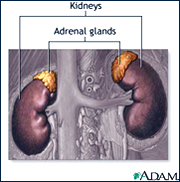Laparoscopic Adrenalectomy
What are the adrenal glands?

The adrenal glands are triangular-shaped glands located on top of the kidneys. They produce hormones such as estrogen, progesterone, steroids, cortisol, and cortisone, and chemicals such as adrenalin, norepinephrine, and dopamine.
The adrenal glands are small yellow-bronze organs found in the retroperitoneum, (the back of the abdomen behind the abdominal lining) usually near the top of each kidney.
They provide essential hormones that control the body's fluid and salt regulation, blood pressure, muscle development, sexual drive and development and sugar metabolism, as well as serving as the source for epinephrine, also called adrenaline. Like the kidneys, only one adrenal gland is usually required to live a normal life. The removal of an adrenal gland is an operation called, naturally enough, an adrenalectomy.
What are some reasons for having an adrenalectomy?
Adrenalectomy is primarily done for tumors of the adrenal gland. It is performed for a variety of benign and malignant conditions, ranging from pheochromocytoma and hyperaldosteronism (primary and secondary) to adrenal cancer.
The traditional method of removal has been either through incisions on the front of the abdomen or through an incision in the lower back. Both of these incisions are occasionally associated with pain and prolonged recovery periods. The laparoscopic approach can reduce the pain and disability associated with these incisions.
When is a laparoscopic approach indicated?
For many benign conditions, especially Conn's tumors and sporadic pheochromocytoma -- both of which are benign tumors that can secrete hormones that make the patient's blood pressure extremely high -- and for hormonally inactive tumors found while looking for some other condition, laparoscopic adrenalectomy is an excellent alternative.
How is the laparoscopic technique performed?
Laparoscopic adrenalectomy is a surgical technique used to remove the adrenal gland without making a big incision. Removing an adrenal gland using a laparoscope is a technically demanding procedure that calls for specialized skills and training. It offers a substantially better view of the gland and its surroundings than one can get with either of the more traditional approaches described above.
Laparoscopic procedures involve the insertion of a telescopic camera system through a small incision in the abdominal wall. Additional small incisions are made through which instruments are inserted to perform the operative procedure and to hold or manipulate tissue in the abdomen. Parts of the adrenal gland are freed from surrounding tissue.
The tumor is then placed into a small bag and withdrawn from the abdominal cavity through one of these small incisions.
What are the advantages of the laparoscopic approach?
For those carefully selected patients who are well-suited for the procedure, people who undergo laparoscopic adrenalectomy have done much better than those receiving the standard, "open" operations, with a much quicker return to normal activity, a shorter hospital stay, less need for pain medication, and a markedly lower incidence of complications.
When is the standard (open) procedure indicated?
It is generally accepted that for adrenal cancer and for conditions where there is a high risk of adrenal cancer, such as for large (4-7 cm) tumors or for those associated with multiple endocrine neoplasia, an "open" operation is better because both sides can be examined carefully and dealt with in the event of spread.
Why should patients come to the University of Maryland Medical Center?
We have dedicated endocrine surgeons with a great deal of experience with adrenal surgery who are nationally recognized experts in performing and teaching laparoscopic procedures. They are among the most experienced laparoscopic retroperitoneal surgeons in the world.
